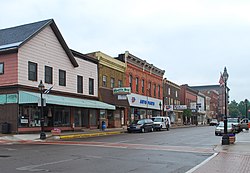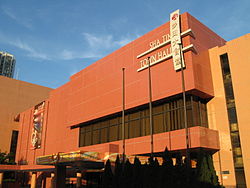Town
A town is usually a place with a lot of houses, but not a city. As with cities, there is more than one way to say what a town is in different countries. In some places, it is a kind of local government. When they say "town" people are normally thinking of a big, important place. It may even be a city.
Generally, a town is smaller than a city and larger than a village, but that is not always the case, and the definition can differ in each country.
Generally, the difference between towns and villages or hamlets is the sort of economy they have. People in towns usually get money from industry (factories etc.), commerce (shops etc.) and public service (working for the town), not agriculture (growing food).
The number of people who live in a place does not tell us if it is a town or a village. In many areas of the world, like India, a big village can have many more people than a small town. It is also difficult to say if a place is a town because today, some towns are becoming bigger.
Sometimes a place is a city because it got the name "city" by law. However, people often call a place a "town" if it is small.
In the Middle Ages, a place became a town by means of a town charter, which gave it town privileges.
United States
In the United States of America, the meaning of the term town is different in each state. In some states, a town is a town if the state says it is. In other states, like Wisconsin, a town is a subdivision of a county. In other states, like Michigan, the name "town" has no official meaning. People use it to describe any place where many people live.
In the six New England states, a town is a smaller part of the county. In all six, towns do things that, in most other states, the counties do. In many of these towns, town meetings are the main form of government, so citizens can say what happens where they live by direct democracy. In these states, the towns are really more important than the county. In Connecticut and Rhode Island, counties are only on the map and have no power. In the other four states, courts are the main work of counties. The counties with other functions are mostly in New Hampshire and Vermont.
Alabama
In Alabama, whether or not a place is a "town" or a "city" is based on how many people live there. A place with 2,000 people or more is a city. A place with less than 2,000 people is a town (Code of Alabama 1975, Section 11-40-6). For legislative purposes, places are put into eight categories based on the number of people. Class 8 includes all towns, and it includes all cities with that have less than 6,000 people (Code of Alabama 1975, Section 11-40-12).
California
In California, any incorporated place can call itself a town or a city. This is not related to how many people live there.
Kansas
All incorporated places in Kansas are called cities. Once a city is incorporated in Kansas, it will continue to be a city no matter what. There are three categories for cities:
- 3rd Class Cities - When a city incorporates, it becomes a 3rd class city. To incorporate, a city must generally have at least 300 people living there.
- 2nd Class Cities - A city may ask to become a 2nd class city when there are 2,000–15,000 people living there. A city that has 2,000–5,000 people may choose to still be a city of the 3rd class. However, they must become a 2nd class city when they have 5,000 people.
- 1st Class Cities - A city may ask to become a 1st class city when at least 15,000 people live there. A city with only 15,000–25,000 people may choose to still be a 2nd class city. However, it must become a 1st class city when they have 25,000 people.
Louisiana
In Louisiana, a "town" is a place that has a city government, and it has 1,001–4,999 people living there.[1]
New York
In New York, a town is also a smaller part of the county, but it is less important than in New England. Towns provide almost all municipal services to places, called hamlets, that are not in villages, and some services to places that are in villages. In New York, a town usually has some hamlets and villages. But, because villages have power without towns (they are independent) they can be in two towns or even two counties. Everyone in New York State who does not live in an Indian reservation (a special place for American Indians) or a city lives in a town, and perhaps in one of the town's hamlets or villages. A city may be part of a county, but even if it is surrounded by a town that has more people than the city, it is not part of the town.
Utah
In Utah, the terms "town" and "city" is based on the number of people living there. A place with 1,000 or more people is a city. A place with fewer than 1,000 people is a town. Cities are divided into five different categories based on the number of people.[2]
Virginia
In Virginia, a town is similar to a city, but it can have a smaller number of people in it. By Virginia law cities are independent of counties (they have power without counties), towns are part of a county.
Wyoming
Wyoming law says towns are incorporated places that have less than 4,000 people living there. Places with 4,000 or more people are "first-class cities".[3]
England and Wales
In England and Wales, the name "city" is only for places that have a Royal Charter (a special document) saying they can have that name.
In the past, cities usually had a cathedral. Some English people think that a place with a cathedral must be a city, but it is not true today. For example, Northampton, Blackburn and Middlesbrough (where is the cathedral??) are all towns with a cathedral.
In the past, a place was usually a town, not a village, when it had a regular market or fair (a market, but not so often). There are some English villages (for example Ipswich, Oxfordshire) larger than some small towns (e.g. Middleham, North Yorkshire).
Japan
In Japan, The population of a town (町) is less than 50,000 people.[4]
TownNew York Media
The city of Hancock, Michigan along Quincy Street
The town of Sastamala, Finland
The town of Salins-les-Bains, France
Putbus on Rügen Island, Germany
Nearly every town in Hong Kong has its own town hall. The picture shows the Sha Tin Town Hall in the town of Sha Tin.
Town of Húsavík in Iceland
A street in Paravur town, India
References
- ↑ "Individual State Descriptions: 2002" (PDF). Retrieved 2018-04-18.
- ↑ "Utah Code, Title 10, Chapter 2, Section 301". Utah State Legislature. Archived from the original on August 8, 2011. Retrieved May 11, 2010.
- ↑ "Title 15 - Cities and Towns; Chapter 1 - General Provisions; Article 1 - Powers and Miscellaneous Matters; 15-1-101. Definitions". State of Wyoming. Archived from the original on 2021-11-02. Retrieved 2022-07-30.
- ↑ "総務省|地方自治制度|地方公共団体の区分". 総務省 (in 日本語). Retrieved 2020-08-20.










